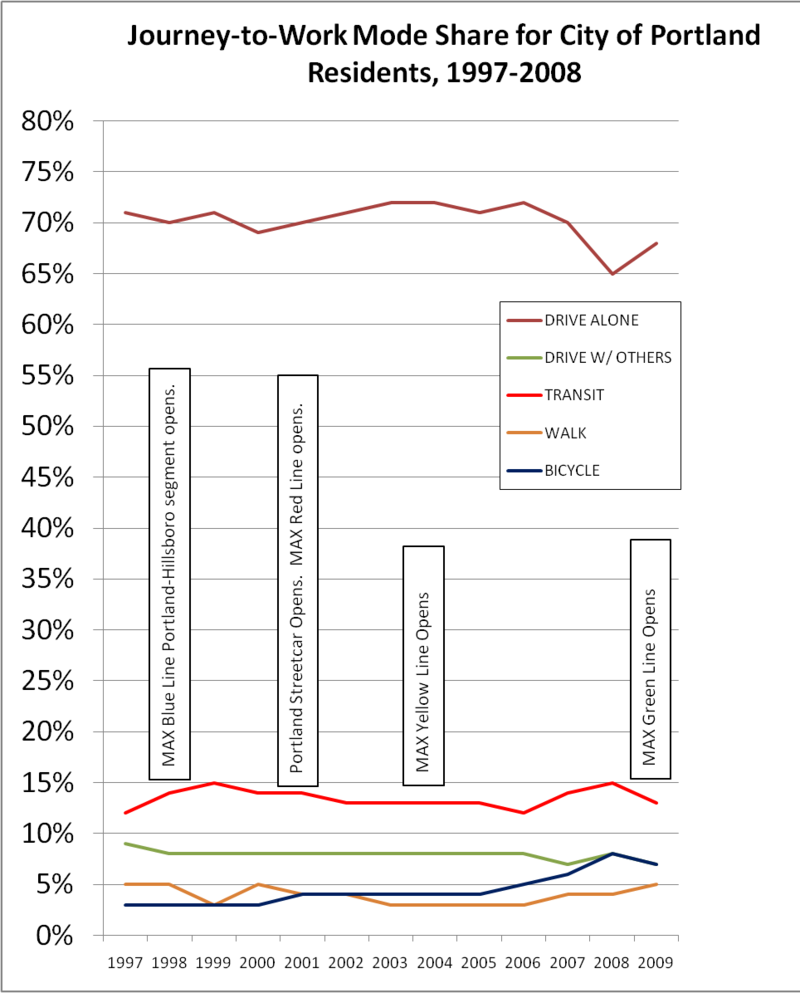Light Rail Ineffective: Portland transit mode-share unchanged despite $4 billion+ in LRT spending
Recently we came across the results of a study on Portland transit mode-share released not too long ago on the Human Transit blog, written and managed by professional public transit planning consultant Jarrett Walker. In the article, called “Portland: A Challenging Chart“, Walker and Portland-based reader Adrian Lawson publish a chart, which shows the trends of journey-to-work mode-share compared over a time span of 12 year; this data is based off the findings of informational surveys asked by auditors for the City of Portland itself every year.
 It is shocking to see that transit mode-share in Portland for all of these 12 years has remained at between 10 and 15% – an effective stand-still.
It is shocking to see that transit mode-share in Portland for all of these 12 years has remained at between 10 and 15% – an effective stand-still.
Since 1997 there has definitely been a reduction in automobile mode share, which is certainly worthy of praise in a world where gas prices are increasing and global warming is becoming a prevalent issue. Some factors such as bike and transit-friendly development—which do not necessarily require transit—and increase in gasoline prices may have assisted in this decrease, but it appears that transit itself has hardly been a part of this difference.
The more recent surveys taken in November of 2010 and just a few months ago in December of 2011 are reporting a continuation in this standstill trend in transit mode-share. In 2010, just 12% of commuting trips were made by transit (a decrease of about 1% from the year before). while 67% of residents were single-occupancy-vehicle drivers.
These numbers more or less remained the same after the conducting of the 2011 survey; although, notably, the percentage of single-occupancy-vehicle drivers among the distributed population actually rose by 1%, and this makes for a startling reality.
While Portland has been recognized as one of the most livable and transit-friendly cities in America, serving as a role model for other cities—including Surrey—it appears that transit mode-share hasn’t actually gone anywhere.
$4 billion+ in LRT spending, no change in mode share
The most startling occurrence is that this standstill occurs despite the opening of 4 new MAX light rail lines and the Portland Streetcar system.
These lines were all built during the 12-year period covered in Human Transit’s analysis of data:
- The Westside extension (1998), linking Portland to the “Silicon Forest” high-tech centers of Beaverton and Hillsboro
- The Portland Streetcar (2001), with further small extensions to RiverPlace (2005) and South Waterfront (2006)
- The Red Line (2001) to PDX airport and nearby undeveloped areas
- The Yellow Line (2004) to Expo Center, just across the Columbia River from Vancouver, Washington.
It is also noteworthy that more than $2 billion in development subsidies can be considered a part of the LRT system’s capital cost. The extra development subsidies accompanied a development outcome that was expected from the LRT, but unable to be brought on by the LRT on its own.
When combined with the $2 billion US dollar capital cost of the above projects, more than $4 billion has been spent for Portland’s LRT system.
MAX Light Rail is slower than SkyTrain
Some have suggested that miscellaneous problems including the abundant availability of cheap or free parking in or near downtown Portland may be contributing to the problem by reducing the potential incentives to use transit. However, MAX lines are also served by free parking at park-n-rides near adjacent stations. Using MAX to complete the trip to work should invoke significant savings over driving the rest of the way due to the savings in gas costs; but it seems that in Portland, transit is still not able to attract the motorist from the car.
How can this city be considered to be highly environmentally friendly and sustainable when more and more people are continuing to choose to drive and not take transit?
In Vancouver, surveys have proven that most rapid transit riders take the ride for the service reliability and speed; but in Portland both the level of services and speed provided by the MAX light rail are not very impressive, especially considering the cost it takes to provide such services. The problems of at-grade, driver-operated LRT as a technology and implementation choice may be problems that are contributing to the lack of increased mode share—especially considering the more than $2 billion in new expansion of the MAX light rail system.
MAX trains operate at a maximum average speed of just 19.3 mph (31 km/h) counting stops [28] – not very competitive with point-to-point auto travel. Low frequencies of 10-15 minutes, even during peak periods, may also be impacting the attractiveness of the line—and increasing this frequency would be tough on taxpayers since the MAX already needs to be subsidized due to the high operating costs of light rail [28].
Maybe Portland is not a good example to follow for Surrey
Transportation: Surrey considers paying its own fare for better transit
Vancouver Sun, Nov 5, 2010; pg. 6 of 104
Why should Surrey be modelling its at-grade Light Rail concept on the Portland MAX, if Portland is hardly a good example to follow?
TransLink has actively set a regional target of reducing vehicular mode-share in the Greater Vancouver area to 50% by 2041, and aiming to increase the mode-share of “sustainable” transit options (cycling, walking and transit) to 50% through increases in service viability and attractiveness; the City of Vancouver itself is actually already close to this target with more than 40% of commuting trips having been made “sustainably” in 2007 [66 – see fig 11], a number that has likely risen further since the introduction of new bus services and the Canada Line.
TransLink is aiming for the same targets in the South of Fraser region and hopes that the goal will be reached by 2041—but can it even reach that goal in time with light rail?
I think the self-congratulatory air you find in Portland concerning livability is due to the fact that it is in America. They pat themselves on the back for doing things that, while exceptional for America, would be considered sub-par and disappointing anywhere else in the world. The bar is set so low in America that even a dwarf could jump it.
In fact, listening to Portland’s elected and unelected officials trumpet the city’s livability is a lot like watching a dwarf win a jumping contest in some perverse new “special” Olympics. You want to cheer for them, you really do. It’s not their fault they were born that way. Nor is it their fault that the competition they are so proud of trouncing is even more inadequate than themselves. So when the gold medal is placed around their neck, a part of you wants to stand up and applaud them for the great effort they have put into life.
But the other part of you can’t really say it’s impressed. And you can’t get over the sneaking suspicion that the whole thing is just a sad, pathetic exercise in helping them to feel better about themselves.
Posted by: Pantheon – 01/11/2010 at 02:47 – Human transit – Portland: A Challenging Chart
About SkyTrain for Surrey
SkyTrain for Surrey is the community organization that advocated for the Surrey-Langley SkyTrain extension. From our beginnings as a petition calling for the scrapping of a street-level LRT proposal, we grew into a community of like-minded folk, taking on various projects such as making SkyTrain an election issue in 2018 as a registered advocacy group. SkyTrain for Surrey continues to call for high-quality transit infrastructure projects serving Surrey, Delta and the Langleys.
Media Contact:
Daryl Dela Cruz – Founder, SkyTrain for Surrey
Phone: +1 604 329 3529, [email protected]
Stay updated with the Surrey-Langley SkyTrain project team!
Be sure to subscribe to the Surrrey-Langley SkyTrain's mailing list (on the contacts page of the Surrey-Langley SkyTrain website) for official project updates! There is also now an official project email to get in touch with the planning team: [email protected].
